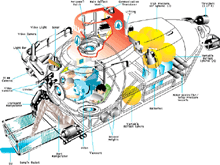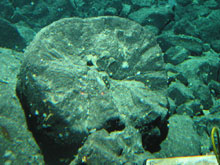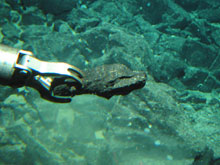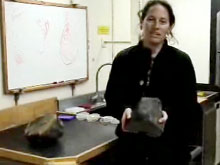
Sampling lava flows on land is far more straightforward when Rachel Teasdale (bottom left) can access active flows directly. Click image for larger view.
![]() See how the claw and arm of the DSV Alvin are able to sample a “wedge” of pillow basalt pulled from a fractured pillow lava. (mp4, 4.8 MB)
See how the claw and arm of the DSV Alvin are able to sample a “wedge” of pillow basalt pulled from a fractured pillow lava. (mp4, 4.8 MB)
Field Geology at Sea
August 18, 2004
Rachel Teasdale
California State University, Chico
I’m just back from Pratt Seamount on DSV Alvin Dive #4037. This was my second dive, and already I’m gaining an appreciation for the challenges of doing fieldwork at 2,880 m (9,504 ft) depth in the sea. I have studied lava flows for the past 10 years, but before this cruise I had worked only on volcanoes above sea level. So, when Dr. Randy Keller invited me to come along and help do some sampling of lavas from seamounts in the Gulf of Alaska, I jumped at the chance. Now I know: I had never fully considered the complexities of undersea sampling.
Our research goal here is to learn more about the ages and composition of the seamounts (see Dr. Keller’s log on August 6, 2004). To achieve this, we hope to collect "fresh" rock samples -- those that have not had their chemical composition changed by exposure to seawater.
The quest for fresh samples drives our study of lava flows on volcanoes above sea level as well; but on land geologists can sample active lava flows. (Generally, I prefer to work on young lava flows -- still flowing -- so I can collect samples with known ages: hours!) Also, on land, we can take several minutes or even hours to examine an outcrop, and we can use sturdy rock hammers, chisels, or drills designed to break apart the rocks to collect a sample. If the pieces we’re looking at don’t look very fresh, we can set them aside and collect something deeper in the outcrop.

Schematic diagram of the DSV Alvin. Notice the tight space for the pilot and two scientists sharing three small portholes for views outside the sub. Click image for larger view.
Sampling from the deep submergence vehicle (DSV) Alvin, we don’t have as many options. We also have the added complexity of looking at the rocks through a porthole that is about 13 cm (~ 5 in) in diameter on one side of the sub. The field of view is further limited by the distance the sub’s lights can penetrate into the darkness of the ocean floor environment (about 10 m).
Since we need to be sure that the samples we collect are from flows of this seamount (rather than rocks that dropped from melting icebergs approximately 20,000 years ago), I look for certain clues in the terrain. I crouch in front of the porthole and peer through the darkness, searching for the vertical cliff face of a pillow basalt -- a unique undersea lava flow structure, defined by an outer rind that is created when erupting lava comes in contact with cold seawater.
When I spot a suitable outcrop of lavas through my porthole, I ask the pilot to take a look. This involves a fair amount of human shuffling inside the small interior of the sub so that he can look through the side porthole to see what I’m pointing at. If the current hasn’t made the sub drift too far past the rocks we’re interested in, the pilot maneuvers to a stable position. Then he manipulates one of the titanium arms to try to grab the sample.
The arm has a claw on the end that the pilot can open and close, but the prospect of using this $150,000 arm as a rock hammer is not popular. Often the sample we want is too-far embedded for the claw to hold onto as the arm tries to wrench it free. The pilots give it their all, but with long “to do” lists during the course of a 4-5 hr dive, we can’t afford to spend too much time on a single stubborn sample.

This image is a cross sectional view through a fractured pillow basalt. The outer curved surface is the chilled rind, and the “wedges” that radiate from the center are fractures, caused by rapid cooling of molten lava in the cold seawater. The red laser points are 10 cm (~4 in) apart, giving the observers in the submarine a sense of scale. Click image for larger view.

This image shows the claw and arm of DSV Alvin grasping a “wedge” of pillow basalt pulled from a fractured pillow. Here the claw is grasping the pillow interior end and the rind is at the far right of the sample. Click image for larger view.
I can’t help but compare our work here with that on land. I think of our deep-sea work as something like doing geology at night with a flashlight: only the light is on intermittently, just long enough to check the map and grab a sample from which we can put the pieces together to reconstruct the geologic history.
Except at sea, we get to dive in Alvin.
Sign up for the Ocean Explorer E-mail Update List.

























